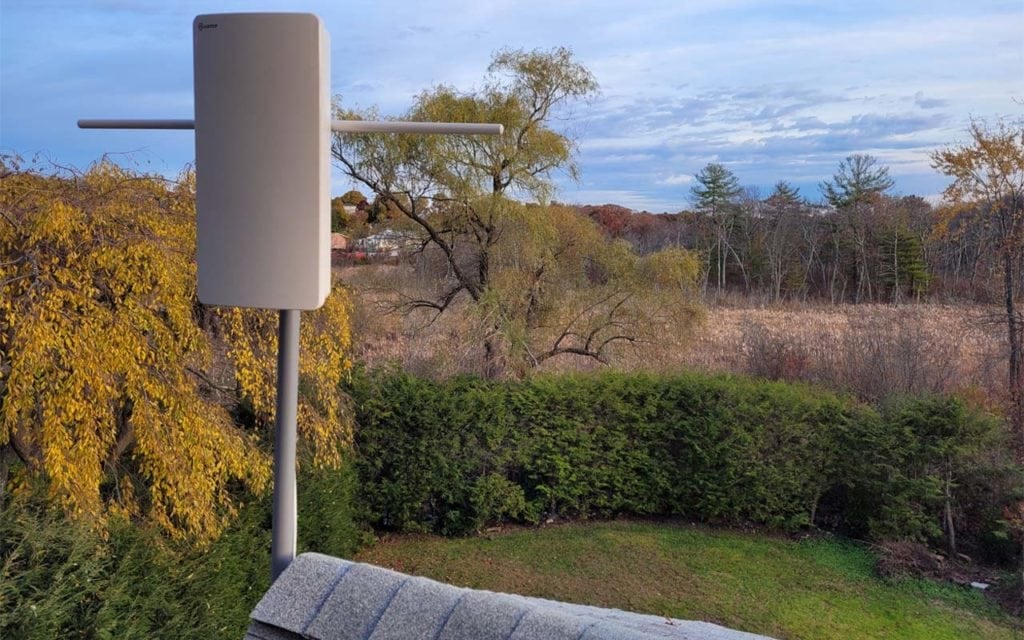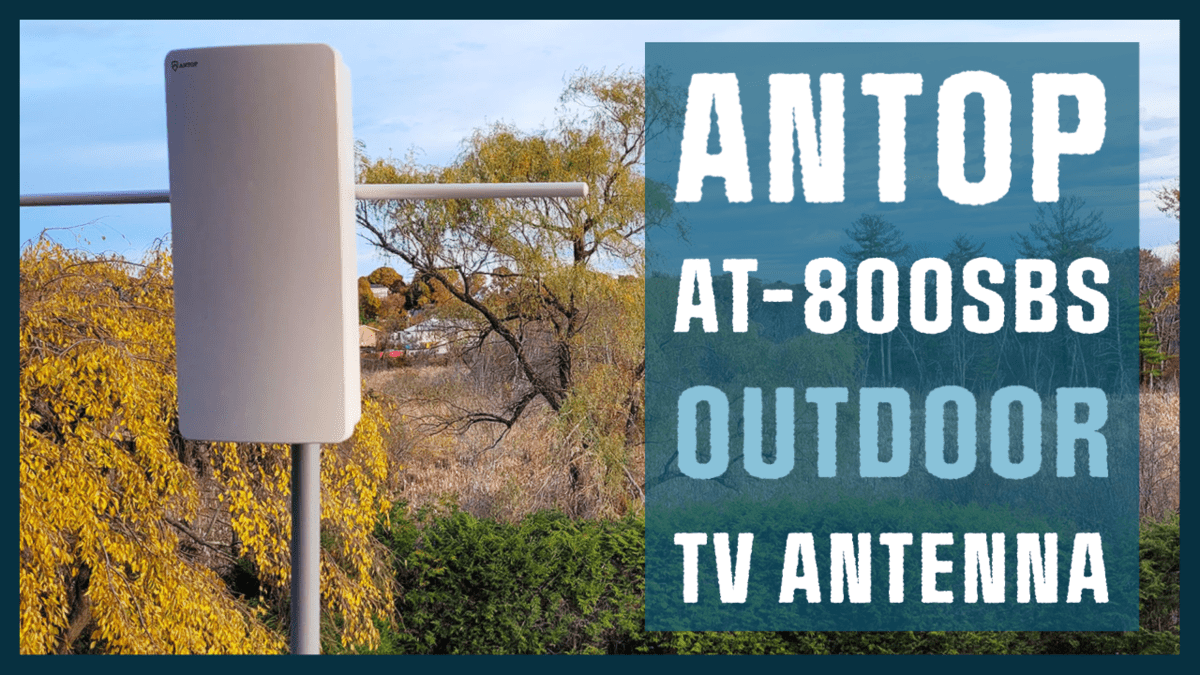The Antop AT-800SBS is the latest model from the company’s “Big Boy” series of outdoor TV antennas.
It’s a follow-up to the Antop AT-400BV, which I have been recommending since 2017 as one of the best outdoor TV antennas on the market.
The 800SBS is a multi-directional TV antenna that includes a full mounting kit, and elements for receiving UHF and VHF channels.
The AT-800SBS was released in 2020. The antenna has the same dimensions and overall design as its predecessor, the 400BV. Both models weigh just under 10 lbs.
The key difference between the AT-800SBS and the AT-400BV comes with its amplifiers.
The AT-800SBS has an adjustable amplifier that Antop also sells as a standalone product. SBS stands for Smart Boost System. The 400-BV uses a smaller amplifier (called the Smartpass Amplified system) that you can easily switch on and off.
Both amplifiers have a built-in 4G LTE filter that blocks 3G and 4G wireless signals that can impact digital TV reception.
Antop recently sent me a AT-800SBS to review from where I live in Boston. I am including recent results from testing the 400BV in Maine and Los Angeles for comparison.
Table of Contents
- Antop AT-800SBS Design
- Antop AT-800SBS weather resistant finish
- Antop AT-800SBS Setup
- Antop AT-800SBS Performance
- Conclusion
- Where to buy
Antop AT-800SBS Design

The Antop AT-800SBS is a smart panel antenna built to receive both UHF and VHF signals.
The body of the antenna has a vertical rectangular shape. It is made of heavy duty plastic with a weather-resistant finish. The AT-800SBS antenna comes with two VHF rods that screw into a pair of mounting holes in the back of the panel. The poles are positioned horizontally for VHF reception.
The antenna includes 40 feet of coaxial cable that is coated with a rubberized finish, and a weather-resistant hood surrounds the coaxial port that connects to the antenna.
The size of the antenna is similar in height to other outdoor TV antennas.
The AT-800SBS is about two feet tall and includes a pre-installed metal bracket for mounting to a pole or the side of a house.
Antop says that the antenna can be used indoors. A stand is included for using the antenna indoors. But the AT-800SBS is made for outdoor use given its size and the mounting bracket.
Antop AT-800SBS weather resistant finish
Just like the 400BV, the AT-800SBS has the same waterproof, and weather-resistant finish.
The plastic casing on the antenna, and the rubberized hood on the coax cable protects the metal components against harsh weather conditions.
The added protection makes these outdoor antennas very useful in coastal areas where salt air can corrode metal antenna elements.
The rubberized hood covering the end of the coax cable tucks into a slot on the antenna so that no metal components are exposed to the outdoors.
Antop AT-800SBS Setup

There are two ways to mount the Antop AT-800SBS outdoors.
You can mount this antenna on a roof peak or side of a house. The easiest way to do this is to remove the metal bracket from the backside of the antenna.
Once the bracket is screwed into the wall or roof peak, re-attach it to the antenna using the fastening bolt.
To maximize reception from distant over-the-air broadcast towers, I mounted the Antop AT-800SBS on the roof of my home.
I bought a 38-inch mast pole made by Winegard after trying a shorter J-pole from Antop. The metal bracket and mounting hardware included with the AT-800SBS makes attaching the antenna to the Winegard pole fairly easy.
Using the mounting pole also helped when it came time to re-position or adjust the direction of the AT-800SBS for the best reception. The roof peak was about 30 feet from the ground. The 40-foot cable dropped straight down to the ground floor.
Inside my garage, I had the antenna connected to a Tablo Quad, an over-the-air DVR that makes OTA channels available across my home Wi-Fi network and Smart TVs.
Antop AT-800SBS Performance
While the company claims that the AT-800SBS has an 85-mile range, receiving signals being broadcast from 50 or 60 miles away is more realistic.
Much like its predecessor the Antop 400-BV “Big Boy”, mounting the AT-800SBS to a roof or a pole delivers the best performance. You will get the most UHF and VHF channels available in your area.
Here are testing results from the AT-800SBS and its sibling model the 400-BV “Big Boy” model.
Massachusetts reception
The AT-800SBS had no problem picking up more than 68 channels from nearby broadcast towers surrounding my home in Boston, and further UHF stations in Rhode Island.
I mounted the AT-800SBS to the Winegard pole, which was installed at my roof’s peak about 30 feet above ground.
My new channels with the AT-800SBS included an ABC affiliate out of New Bedford, Mass., which was on the UHF band more than 30.25 miles away.
An NBC affiliate out of Providence, Rhode Island more than 30 miles away also comes in crystal clear.
When facing the antenna north, I wasn’t able to get the ABC affiliate in Manchester, New Hampshire, which is on the VHF band. That station’s tower is roughly 50.5 miles away. However, three sub-channels on the UHF band from that same tower came in just fine.
But overall, I was pleased with the channels that I was able to get at this location.
Los Angeles, Calif. reception
My brother and his son installed the Antop 400-BV, a predecessor to the 800SBS, on the roof of their home near the beach. The majority of the towers were on Mt. Wilson about 31 or 32 miles away.
Using materials around the house, they created a pole with some PVC pipe that was anchored by a five-gallon bucket.
In Los Angeles, a number of stations are still broadcasting on the VHF band, including the local FOX and ABC stations. (NBC and PBS are on the UHF band.)
They had tried an indoor antenna at first, which got them more than a dozen channels. They also tried using a ClearStream Fusion by Antennas Direct that was mounted outside, but not on the roof. That didn’t change the number of channels they received by much.
With the Antop they get about 175 channels (Channels 2-64). The added channels included local stations for local news and sports, including NFL games.
They include the local FOX and ABC stations. (NBC and PBS are on the UHF band.)The majority of the towers were on Mt. Wilson about 31 or 32 miles away.
I was curious about whether they could get anything beyond 30 or 40 miles – so I asked about whether they could get a PBS station in San Bernardino that had a tower about 64 miles away. They couldn’t get a signal from that station.
But they still had a dramatic improvement with their channel lineup – mostly thanks to the VHF elements on the antenna, and by placing it on the roof.
Maine reception
When I tested the Antop 400BV a few years ago at my in-laws located in York County in Southern Maine, I was able to get 30 channels – mostly out of the Portland area. Those towers were located between 36 and 38 miles away.
And there was one New Hampshire station that was 53 ½ miles away that we were able to get. The channel itself wasn’t anything great, but it demonstrated that channels in the 50 mile range were definitely possible.
Conclusion
Based on all my testing, the Antop AT-800SBS is a good buy if you want free over-the-channels and your towers are about 50 miles or under.
Of course, the local terrain and obstacles such as mountains, power lines or tall trees can impact your signal. I hope this video was helpful and gave you some general guidance with choosing an outdoor TV antenna.
Where to buy
- Antop AT-800SBS at the Antop website (free shipping)
- Antop AT-800SBS at Walmart
- Antop AT-400BV “Big Boy” at the Antop website
- Antop AT-400BV “Big Boy” at Walmart
For more news on streaming, how-to guides and reviews, head over to the main page of The Cord Cutting Report or follow the CCR on Google News.
